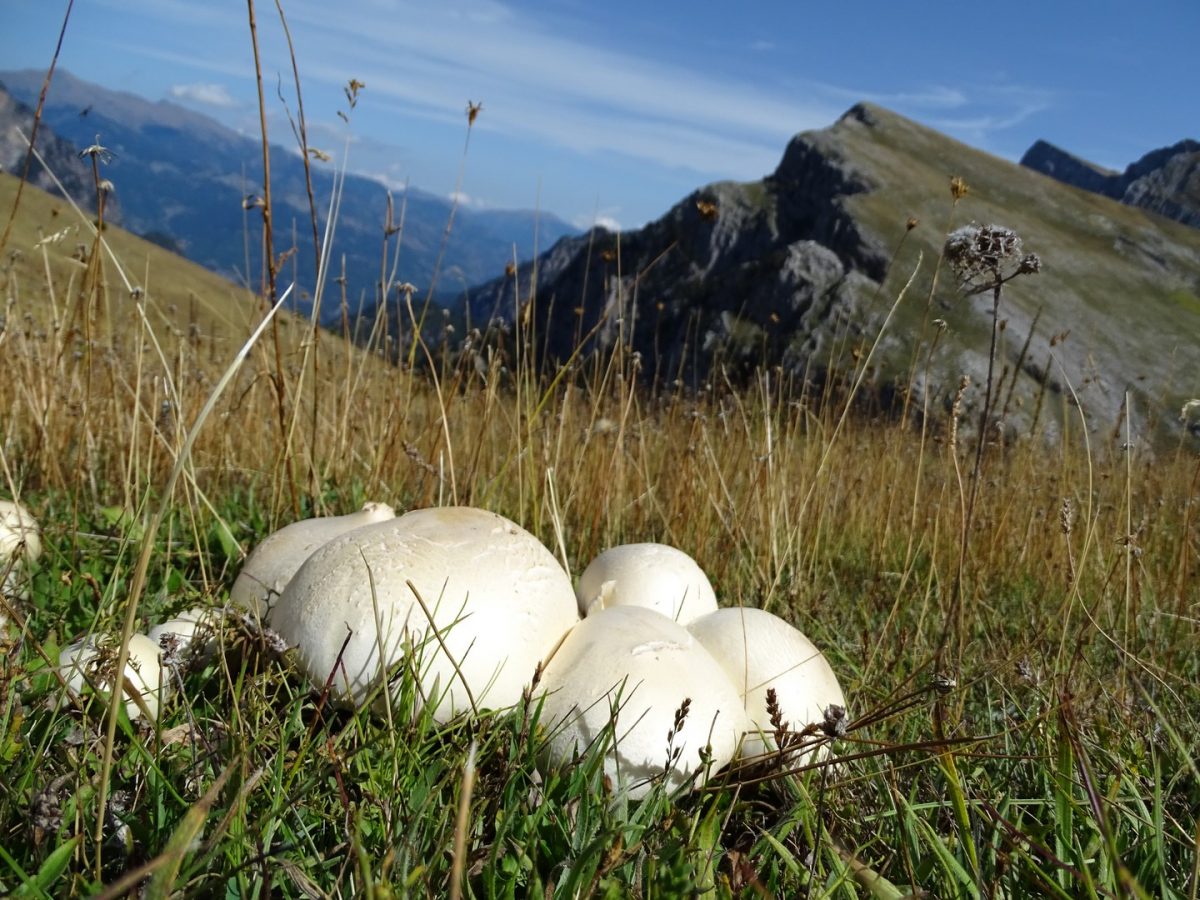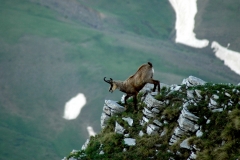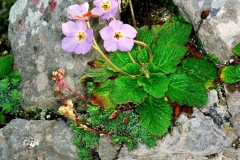The biological richness
Ecosystems
Vikos-Aoos Geopark includes five distinct types of characteristic ecosystems, clearly distinguished by the dominant vegetation. At lower altitudes (375 m to 700 m) we encounter ecosystems of evergreen sclerophyllous shrubs and then oak forest ecosystems (700 m – 1.000 m).
In the mid altitudes (1.000 m to 1.600 m) there are coniferous and beech forests while at high altitudes (1.600 m to 2.000 m) there are bosnian pine forests and at even higher altitudes (2.000 m to 2.637 m) subalpine and alpine meadows.
These ecosystems are quite often spread over relatively large areas or form mixed sets, creating the impression of a complex mosaic where individual sections can be distinguished by the particular leaf color of the different trees.
However, beyond these five major ecosystems, there are also others which occupy smaller areas, such as rocky slopes, gorges and vertical cliffs of high mountains, as well as aquatic ecosystems (lakes, rivers) and riparian vegetation ecosystems. There are also “anthropogenic ecosystems”, which are decisively shaped by human impact as is the case of Konitsa plain.
All these ecosystems host remarkable numbers of wild fauna and flora species, the number and variety of which depends largely on their particular ecological requirements. In the wider area of the Geopark more than 1.700 plant species and subspecies have been found, while wildlife is equally rich as the wider area’s ecosystems host around 250 species of vertebrates and numerous invertebrate species.
The wild fauna
The Geopark’s wider area has rich wild fauna as regards both species number and the presence of rare and protected species in accordance with the Greek and European legislation. Almost all the large mammal species of the Greek mainland occur here.
Some of them are rare species, such as the bear (Ursus arctos), the wolf (Canis lupus), the wildcat (Felis sylvestris), the otter (Lutra lutra), the Balkan chamois (Rupicapra rupicapra balcanica) and the roe deer (Capreolus capreolus), which occur in the area with several other common species, such as the wild boar (Sus scrofa), the fox (Vulpes vulpes), the badger (Meles meles), the hare (Lepus capenis), the hedgehog (Erinaceus concolor), the squirrel (Sciurus vulgaris), and the marten (Martes foina) etc.
In the wider area of the Geopark 60 mammal species have been recorded.
Among the area’s 161 bird species, raptors are of special interest such as the Egyptian vulture (Neophron percnopterus), the golden eagle (Aguila chrysaetos), the peregrine falcon (Falco pereginus), the short-toed eagle (Circaetus gallicus), and the lanner falcon (Falco biarmicus).
There is a high presence of woodpeckers, including the large black woodpecker (Dryocopus martius), the Balkan woodpecker (Dendrocopos syriaca) and several other bird species such as the rock partridge (Alectoris graeca), the willow tit (Parus montanus) and the wallcreeper (Tichodroma muraria).
Several other bird species are equally interesting, such as those associated with aquatic and riparian ecosystems and observed either permanently or seasonally, like the white throated dipper (Cinclus cinclus), the white stork (Ciconia ciconia), the black stork (Ciconia nigra) the little egret (Egretta garzetta) and very rare the night heron (Nycticorax nycticorax).
In the area there are also 11 amphibian species, the most interesting being three of them: the salamander (Salamandra salamandra), the alpine newt {Ichthyosaura (=Triturus) alpestris} and the common toad (Bufo bufo).
Of the 20 reptiles, two species of tortoises are of special interest: the marginated tortoise (Testudo marginata) and the Hermann’s tortoise (Testudo hermanni) as well as the European pond turle (Emys orbicularis).
Finally among the 11 fish species of the area we should mention an endemic species of Sarantaporos and Aoos river, the “Pindovinos” (Oxynoemacheilus pindus) and the most common species that attract the interest of amateur fishermen such as the brown trout (Salmo trutta), the chub (Leuciscus cephalus), the common nase (Chondrostoma nasus) and the Peloponnese Barbel (Barbus peloponnesius).
The flora
In the wider area of the Geopark there is a large number of plant species as more than 1.700 taxa (species and subspecies) have been recorded in the area.
The Geopark’s floristic value is rather significant, taking into consideration that this number corresponds to 1/4 of our country’s plants.
This is due to the large altitude variations and the diverse terrain of several distinct massifs with different geological bedrock ranging from 375m to 2.637 m altitude in relation with the local specific environmental conditions.
Most of the area’s flora species and subspecies haven’t got a common name because man focused only on some of them, especially to those related to a particular use or simply because he was impressed by the beautiful colors of their flowers. Among the most spectacular mountain flowers in the Geopark territory attracting visitors’ attention are the wild lily species of the Lillium genus, found almost exclusively in forested areas and distinguished by their size and vivid colors.
These five species are: the white lily (Lillium candidum), with white color that occurs very rarely and usually around settlements, as the Prophet Elias of Konitsa and the Vikos Gorge, the Lillium chalcedonicum and the Lillium heldraichi with red color found in forests, such as in Central Zagori and Vikos Gorge, the Albanian Lilly (Lillium albanicum) with yellow color found in Smolikas and finally the Martagon Lilly (Lillium martagon) with pink color thriving in mountains, as in central Zagori and Aoos Gorge.
Other plant species of the Geopark’s mountains, having very beautiful flowers are the Poet’s narcissus (Narcisus poeticus) with white flowers that grows in forests clearings, the wild tulip (Tulipa sylvestris spp. australis) with yellow flowers in sunward slopes of forests and meadows, the Spring gentian (Gentiana verna) with its deep blue flowers found in subalpine meadows, the houseleeks with red flowers (Semprevivum marmoreum) or yellow flowers (Jovibarba heufelli) and various saxifrages, such as Saxifraga spruneri and Saxifraga marginata, occupying the rock crevices at high altitudes.
Among plants with medicinal properties the most interesting are: the mint (Mentha longifolia), the common sage (Salvia officinalis), the winter savory (Satureja montana), the thyme (Thymus leucospermus), the mountain tea (Sideritis raeseri & S. montana), the hellebore species (Helleborus cyclophyllus), the spurge olive (Daphne oleoides), the rosebay willow-herb (Epilobium angustifolium), the hemlock (Conium maculatum), the myrtle spurge (Euphorbia myrsinites), the dwarf elder (Sambucus ebulus), the white hellebore (Veratrum album) and many more.
Of particular interest is the mountain flora in areas with ophiolite geological substrate, i.e. Smolikas mt, where some species, well adapted to high metal concentration soil, exist: (Allysum smolicanum, Allium sphaerocephalon, Viola albanica, Gallium ophiolithicum, Cerastium smolicanum, Centaurea ptarmicaefolia and others.
Moreover, on the Geopark’s mountains many rare, native and endangered species occur. Some of the most interesting endemic plant species are the following: Centaurea tymphaea, Sedum tymphaeum, Centaurea pawlowskii, Bornmuellera tymphaea, Alyssum heldreichi, Silene pindicola, Onosma epirotica, Minuartia pseudosaxifraga, Valeriana crinii, Soldanella pindicola, Saxifraga biflora epirotica, Galium sacrorum, Hieracium dasycraspedum.
Finally it is worth mentioning few other species of the area, such as the Serbian phoenix (Ramonda srebica), found exclusively in the Vikos, Voidomatis and Aoos Gorges, the insectivorous Pinguiculla crystallina ssp hirtiflora, found mainly in Smolikas mt and the German iris (Iris germanica) that occurs in the narrow ledges on Timfi’s cliffs.
Protected Areas
Vikos-Aoos Geopark encompasses the entire area of 3 Natura 2000 sites (Vikos – Aoos National Park, Timfi mt and Central Zagori) and a significant part of three additional Natura 2000 sites {Smolikas mt, Mitsikeli mt and Douskon / Meropi (Nemertsika) mt}.
Moreover, almost the entire area of the Vikos-Aoos Geopark is located in the Northern Pindos National Park, which is the largest mainland protected area in Greece, covering an area of 2.000 km2. It was established in 2005 after the union of two pre-existing smaller National Parks, Vikos-Aoos National Park and Pindos (Valia Calda) National Park.
The Northern Pindos National Park consists of four distinct zones of graded protection. Among the most important zones are the Nature Protection areas and the Habitat and Species Conservation Zone, which both encompass most of the Vikos-Aoos Geopark surface.







Τα σχόλια είναι κλειστά!